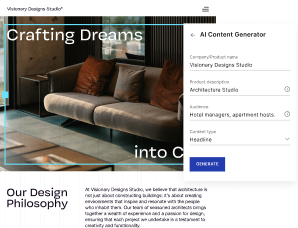Inbound marketing has gotten a lot of great press in the last decade or so. Punch the term into Google and you’ll find countless warmly worded articles about “delighting customers” and “building a relationship with prospects.” Swoon.
On the other hand, search its counterpart, “outbound marketing,” and you’ll find a million fewer results filled with negative language like “interruption,” “in-your-face,” and “irrelevance.” Some blog posts even go so far as to proclaim its death:

So if outbound marketing is really dead and we’re living in the age of inbound, then why do some businesses seem to be split on which method is the most effective for accomplishing marketers’ number one goal in 2016 (generate leads)?
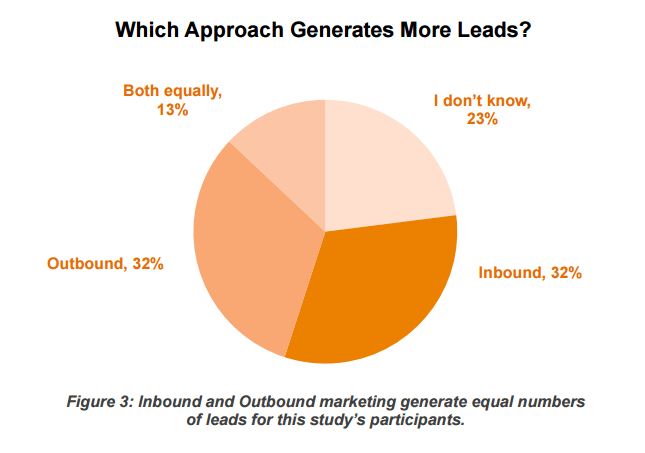
Why do those same businesses rank inbound and outbound marketing importance so similarly on a scale from 1-10?

The answer is: because outbound marketing is very much alive and well. And it’s still a valuable part of any lead generation strategy.
But to understand why, you first need to understand the difference between outbound and inbound marketing — which isn’t as clear-cut as you might assume.
Outbound marketing vs. inbound marketing
The easiest way to differentiate between inbound and outbound marketing methods is by thinking of them in terms that Seth Godin coined the late 90’s: interruption marketing and permission marketing.
“Interruption marketing” (outbound marketing) is a strategy you’re more familiar with than you probably realize. It refers to marketing tactics that disrupt our daily routines — messages on signs, busses, billboards, and during TV shows, for instance:
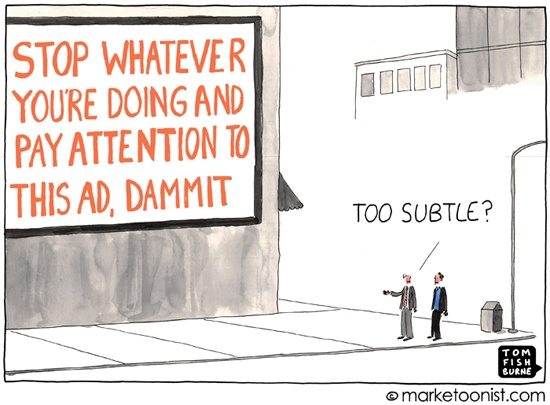
Before the internet, as Godin describes, these tactics were a fairly effective way for businesses to market their products and services:
“Marketing is a contest for people’s attention. Thirty years ago, people gave you their attention if you simply asked for it. You’d interrupt their TV program, and they’d listen to what you had to say. You’d put a billboard on the highway, and they’d look at it. That’s not true anymore. This year, the average consumer will see or hear 1 million marketing messages – that’s almost 3,000 per day. No human being can pay attention to 3,000 messages every day.
If you can stand that kind of ad bombardment, you’re in the minority. Today, most people have already tuned out.
By 2007, 72% of Americans had added their phone number to the “do not call” list to avoid telemarketers. Seven years later, a 2014 study showed that 84% of people wanted to fast-forward through commercials, and that 60% of them downloaded or recorded TV just so they could.
Consumers are more in control of what they see than ever before. With the help of the web, they’ve taken back the customer journey. Studies shows that 81% of buyers do research online before purchasing.
This shift in the way people buy has forced businesses to turn their attention to a new kind of marketing known as “inbound,” or “permission marketing,” as Seth calls it:
“Interruption marketing is giving way to a new model that I call permission marketing. The challenge for companies is to persuade consumers to raise their hands - to volunteer their attention. You tell consumers a little something about your company and its products, they tell you a little something about themselves, you tell them a little more, they tell you a little more - and over time, you create a mutually beneficial learning relationship.”
That practice of “you share something about you and we’ll share something about us” can be defined, in marketing terms, as “lead generation.”
So if permission is the new model and outbound is outdated, then why are some businesses saying they’re equally important to their lead generation strategy?
That’s where things get a little fuzzy.
What is outbound lead generation, really?
We already know that according to Act-On, there’s a split between some businesses when it comes to identifying which method of marketing is best for lead generation. But, what’s also worth looking at is how many people don’t know whether inbound or outbound produces better results.
Almost a quarter of the study’s respondents couldn’t say. And while some might not be tracking their ROI, a big factor contributing to their confusion is likely the continuously evolving definition of “outbound lead generation.”
Some outbound methods of lead generation are easy to pick out. Cold calls, internet pop-ups, and TV commercials are overwhelmingly outbound. Some more outbound methods:
- TV/radio ads
- Print ads
- Press releases
- Outdoor advertising
Others, however, are harder to nail down. What about email marketing? Is that inbound or outbound?
It’s about permission
According to Godin, it all depends on how your business gets subscriber email addresses in the first place:
“Real permission is different from presumed or legalistic permission. Just because you somehow get my email address doesn't mean you have permission. Just because I don't complain doesn't mean you have permission. Just because it's in the fine print of your privacy policy doesn't mean it's permission either.
Real permission works like this: if you stop showing up, people complain, they ask where you went.”
So the answer is, it can be either. If you bought an email list, or you hid some fine print at the bottom of your form that gave you the legal right to email your new lead, then you didn’t really get permission, did you?
In that case, you’re using outbound.
But, if you generated a subscriber using a landing page form like this one, then you’re doing inbound:
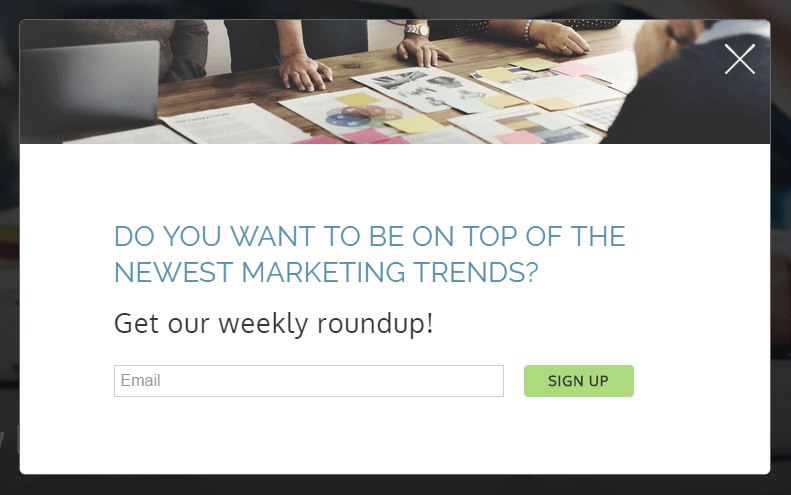
The expectations here are clear: I give you my email address, and you send me a weekly email about marketing trends. That type of straightforward agreement is what businesses should aim for when generating leads.
It’s a great example of what Seth calls “real” permission — which is on one end of the lead generation spectrum. On the other end, there’s the sneaky “legalistic” permission that some marketers will get by hiding jargon deep in terms & conditions. In extreme cases, some don’t get permission at all by purchasing prospect information and email addresses.
For the most part, though, the majority of businesses generate leads using a version of permission that falls somewhere in between those two. So labeling things can get confusing.
Pre-checked newsletter opt-in boxes at the bottom of forms are a great example of a gray-area tactic. Technically by pressing your CTA button without unchecking that box, your visitors are giving you tacit permission to send them e-newsletters. But if they really wanted to receive your updates, they’d check the box themselves.
It’s not about money
Another factor adding to marketers’ confusion is the paid vs. unpaid aspect. Some think “paid = outbound” and “organic = inbound.” And while for the most part, they’re right, inbound and outbound are more complicated than that. If they weren’t, we’d simply call them “paid” and “unpaid.”
Google Ads, for instance, are inbound because they’re only displayed to prospects after they begin searching for a solution to their problem, even though Google Ads is a paid channel.
On the flipside, Moz categorizes influencer outreach as an inbound marketing tactic. But, it isn’t always.
For example, teaming up with an influencer for the purpose of cross-promotion, the way Foundr did with Rich20Something on Instagram, is an outbound method of marketing.
Why?
Because Foundr promoted its posts to Rich20Something’s audience, and vice versa. Rich20Something’s followers on Instagram didn’t ask to see Foundr’s content. If they wanted to, they would’ve subscribed to the company’s updates on their own.
Remember: Inbound marketing puts an emphasis on preparing to be found by a researching prospect, where outbound marketing is about pushing your message to the masses to get it found.
It’s changing with technology
Today’s marketing technology blurs the line even more between the two methodologies.
Take banner ads for example. They used to be the billboards of the internet, and for a long time they were known primarily as an outbound format. But today, dynamic remarketing allows advertisers to reach audiences with more relevant ads based on their behavior.
If a user has abandoned your website and you target them with ads to draw them back, how is that any different than attracting someone with a Google ad?
Larry Kim, founder of WordStream, seemed to have that exact thought years ago:

Maybe the reason 23% of people don’t know whether inbound or outbound marketing generates more leads for their business is that they can’t easily differentiate between the two anymore.
But, should it matter? The inbound vs. outbound debate distracts from maybe the biggest takeaway in the Act-On study:
Nearly 85% of respondents said that regardless of which drives their business, they use a combination of inbound and outbound tactics. Nobody was all-in on either.
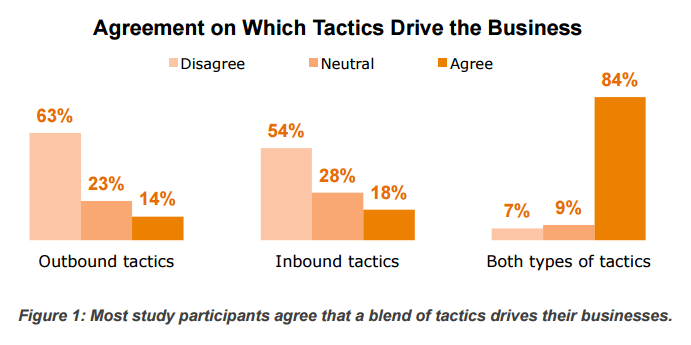
How outbound combines with inbound
Based on that research, it looks like outbound lead generation works best together with inbound. And that makes a whole lot of sense. Like two halves of a whole, each can help the other where it lacks.
Benefits of outbound for lead generation
Build awareness quickly
Growing a following the inbound way can take a long time. It requires publishing relevant and valuable content on a regular basis, earning quality backlinks, and building relationships with influencers. It’s difficult to do even with a roadmap, and it takes a lot of resources to get right.
According to Ascend2, the three most difficult channels for lead generation are content marketing, social media marketing, and search engine optimization — all inbound methods. On the other hand, paid advertising is ranked easier than all three.
That’s probably one of the reasons why, according to AdRoll’s 2016 State of the Industry report, 98% of marketers are planning to maintain or increase their programmatic advertising budget. And according to eMarketer, by the end of 2016, display spending will surpass paid search ad spending.
Tools from Facebook, Twitter, LinkedIn, and Google, all allow businesses to target potential customers with pinpoint accuracy. Name, location, and demographics are just the beginning. Reach prospects based on the sites they visit, the behaviors they exhibit, and even the life events like an engagement, a school graduation, or the birth of a child.
If you know your target audience intimately, outbound can be a powerful way to drive audiences to post-click landing pages where they can claim your offer for a free consultation, a quote, or even inbound content.
Attract new business
Too often marketers are guilty of pronouncing something extinct or irrelevant without considering the data. Take direct mail for instance — you know, catalogs, coupons, and mail-order offers.
In a survey of 1,000 people conducted by Moz and Fractl last year, respondents indicated that direct mail was the most effective at attracting their business.
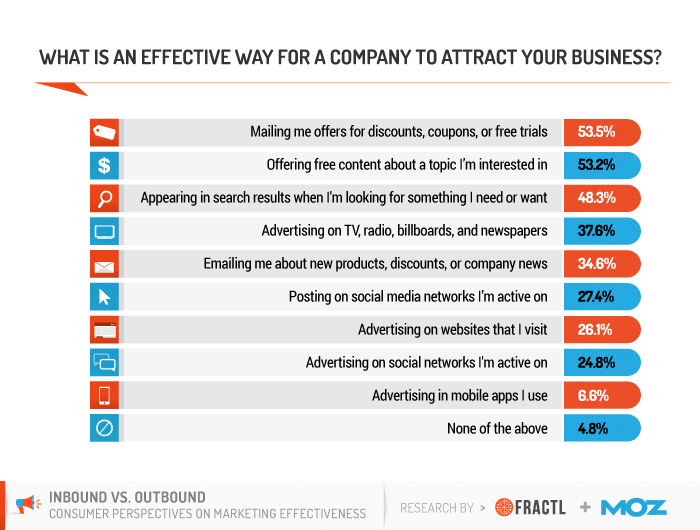
Right below it? Free content, the cornerstone of inbound.
Surprising, right?
If you need further proof it’s still relevant, head over to the Adobe blog and read Bruce Swann’s “Direct-Mail Marketing Isn’t Dead – It’s Immortal.” In it, you’ll find statistics from the Direct Marketing Association that show response rates in young adults have actually risen over the last few years, along with other valuable insights that prove the medium is far from obsolete.
Remember, just because inbound is new and effective doesn’t mean that everything about outbound is old and ineffective.
Another point to recognize is that, according to respondents, traditional advertising is better at attracting their business than email marketing and social media marketing.
Does that mean you should scrap email and social and throw all your marketing budget into traditional advertising?
No. It’s common for people to think one way and behave another. We’re not looking at ROI here, but consumer opinion.
However, do these responses mean that maybe some old-school advertising methods are worth a second look?
Absolutely. The right mix of old and new-school varies from business to business. And they’re not mutually exclusive. From Bruce’s article on direct mail:
[qupte]Instead of addressing direct mail as a channel completely separate from digital touchpoints, start thinking about ways you can use direct mail to engage customers in other channels. Direct mail may be considered the “onramp” for engagement or the moment of reengagement in the customer’s journey. This could be something as simple as emailing your customers a quick-response (QR) code that leads them back to your website or offering loyalty discounts for mail recipients who sign up for your email list.[/quote]
Think about how you can leverage online behavioral data to influence direct mail. For example, if the data shows that I often browse surf attire in the summer, fly-fishing gear in the fall, and snow skiing gear in the winter, why not use those insights to drive content in direct mail?
Instead of thinking “outbound = old, expensive, and interruptive” and “inbound = new, affordable, and attractive,” think of ways they can both be used together to generate leads, like Bruce did above.
Earn attention
In that same study, more than 50% of respondents said traditional advertising was effective at capturing their attention, which according to the study’s author, Kelsey Libert, isn’t out of line with past research. A study conducted in 2014 by Nielsen discovered that radio commercials are key for driving traffic to brick-and-mortar stores, generating an average of $6 in ROI for every $1 spent.
What you do with that attention when you have it will impact whether or not you generate leads with your outbound campaigns. Take this outdoor Uber ad for example:
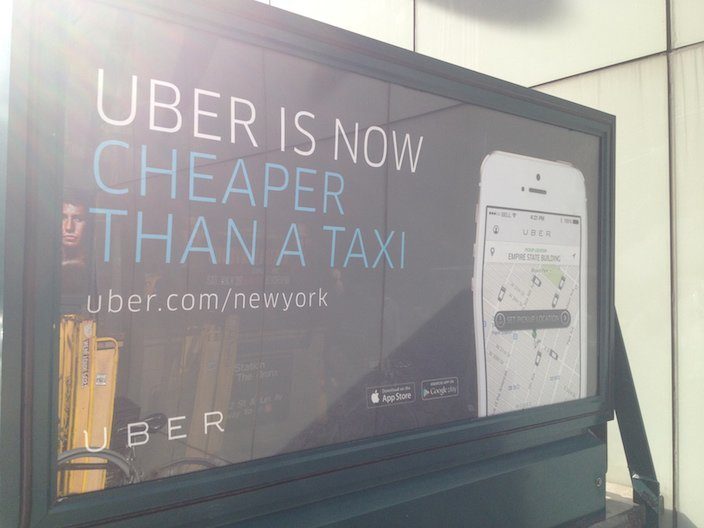
Imagine if it didn’t have that URL on it. The benefit would be expressed clearly, and the viewer might be tempted to use Uber, but they may not know how. The URL is what gives this outbound ad the power to generate leads with the help of this post-click landing page.
So, how do you combine those benefits with inbound to make your lead generation campaigns the strongest they can be?
- Know your target audience like they’re your best friend. That means going beyond age, sex, and geographic location to learn about their goals, interests, and how they behave online.
- Create free, valuable, search-engine-optimized content for that audience based on your research. If your business is as boring as watching paint dry, then make the paint interesting, like Farrow & Ball did by creating a separate site called The Chromologist:
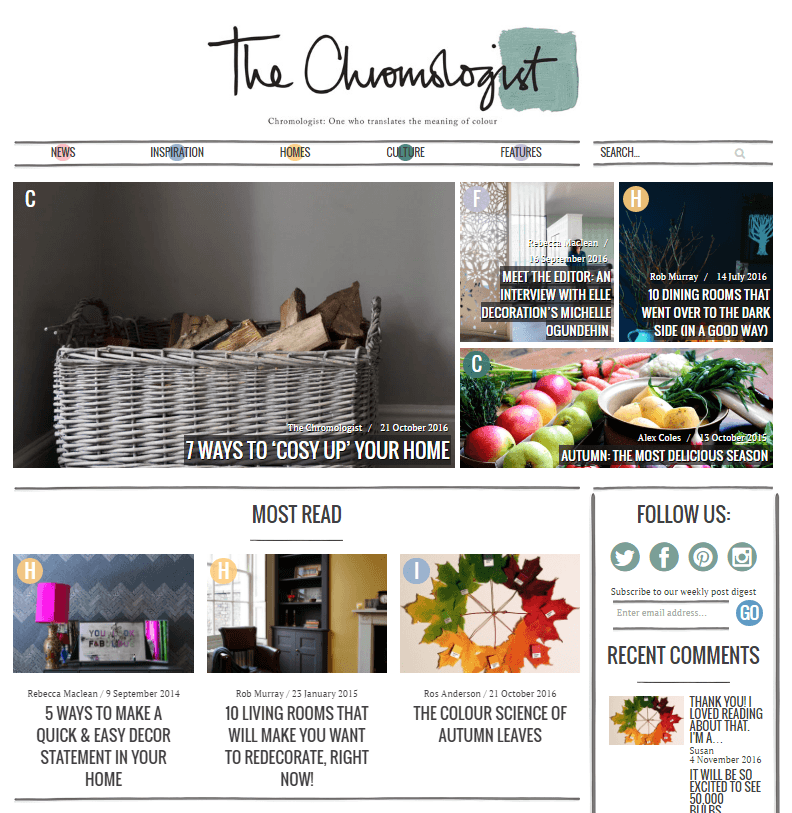
Instead of giving people tips on how to choose the right paint color and wallpaper pattern, the home decor brand takes things a step further with entertaining content like “Hot But Tricky – 15 Ways To Use Orange In The Home,” and “14 Rooms That Prove Navy Blue Is A Classic.”
Remember: the concept of content marketing is boring to most people, but your content doesn’t have to be. Your audience shouldn’t feel like they’re being marketed to at all.
- Amplify that content with outbound methods. Go to Facebook, Google, Outbrain, and test the waters. See where you get the biggest return. Outbound advertising has changed a lot since its death was announced years ago.
First, it’s more effective than it used to be. Technology has improved the relevance of outbound, and now advertisers can reach people that meet their company’s target demographic exactly.
Second, it’s easier to measure. Calculating the impressions of a billboard in Times Square isn’t an exact science, but doing the same for a Facebook ad is.
Third, it’s not as interruptive as it used to be. According to HubSpot, consumers on the whole have a positive view of sponsored ads, email newsletters, and even display ads:
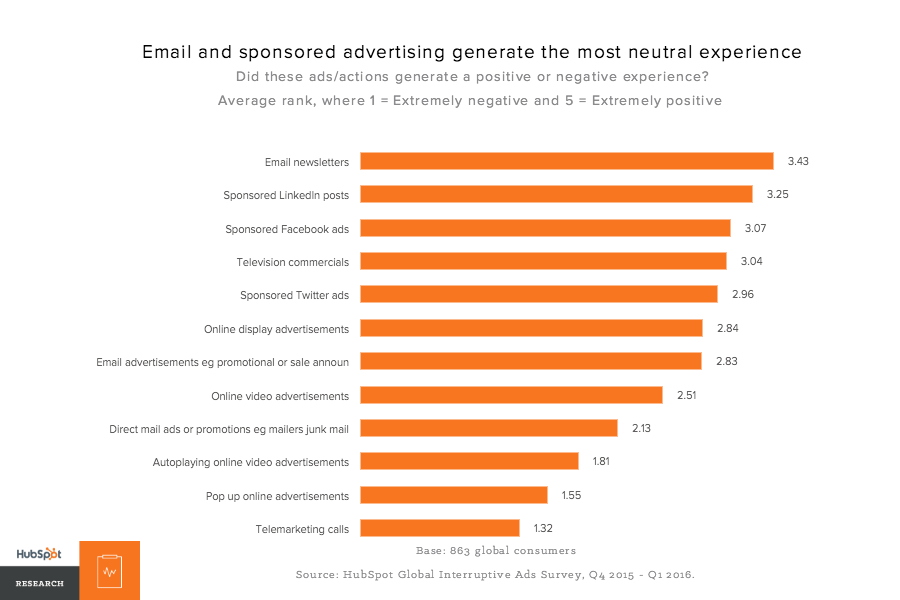
Once you’ve built an engaged audience…
- Generate traffic to a post-click landing page, where you make your prospects an offer. That can be an ebook, a free consultation, a quote, an audit, or anything else that might be valuable to your audience. The key here is “free.”
Give them something that they want at no monetary cost, and ask for only as little personal information as you need to effectively qualify and follow up with them. The less they have to divulge about themselves, the more likely they are to convert.
And remember, each of your lead gen campaigns should have its own post-click landing page. Segmentation and message match are big drivers of conversion rate. So big, in fact, that HubSpot has found that businesses with 40 or more post-click landing pages generate 12x more leads.
Do you still use outbound marketing to generate leads?
Ultimately, how your campaign is identified shouldn’t matter. What’s the ROI? What’s the impact on your customers?
If you’re producing results and they’re still happy, it doesn’t matter. Inbound, outbound, old-school, new-school — they can all be used together.
Forget about labels, get creative and use Instapage to create personalized, post-click landing pages at scale. Sign up for an Enterprise demo today.

See the Instapage Enterprise Plan in Action.
Demo includes AdMap™, Personalization, AMP,
Global Blocks, heatmaps & more.

